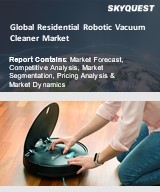
Report ID: SQMIG20N2031

Report ID:
SQMIG20N2031 |
Region:
Global |
Published Date: May, 2024
Pages:
204
|
Tables:
88 |
Figures:
72
The global residential robotic vacuum cleaner market is characterized by intense competition among key players striving to gain a competitive edge through various market-specific strategies. One prevalent strategy is product innovation and differentiation, wherein companies focus on developing advanced features, cutting-edge technology, and superior performance to distinguish their robotic vacuum cleaners from competitors. These innovations may include improved navigation systems, enhanced suction power, longer battery life, advanced sensors, and compatibility with smart home integration platforms. By continuously innovating and offering unique features, companies aim to capture consumer interest and establish themselves as leaders in the market.
Another key aspect of the competitive landscape is branding and marketing efforts. Companies invest heavily in brand building, advertising, and promotional campaigns to increase brand awareness and visibility among consumers. Through targeted marketing initiatives, companies strive to position their robotic vacuum cleaners as premium, reliable, and desirable products that meet the needs and preferences of modern homeowners. Additionally, companies leverage endorsements, partnerships, and celebrity endorsements to enhance their brand image and credibility in the market.
Moreover, pricing strategies play a crucial role in the competitive landscape of the residential robotic vacuum cleaner market. Companies employ various pricing tactics, including competitive pricing, value-based pricing, and promotional pricing, to attract consumers and gain market share. Additionally, companies may offer bundle deals, discounts, and financing options to incentivize purchases and drive sales. By adopting strategic pricing strategies, companies aim to maximize revenue while remaining competitive in the market.
Top Player’s Company Profiles
Our industry expert will work with you to provide you with customized data in a short amount of time.
REQUEST FREE CUSTOMIZATIONWant to customize this report? This report can be personalized according to your needs. Our analysts and industry experts will work directly with you to understand your requirements and provide you with customized data in a short amount of time. We offer $1000 worth of FREE customization at the time of purchase.

Report ID: SQMIG20N2031